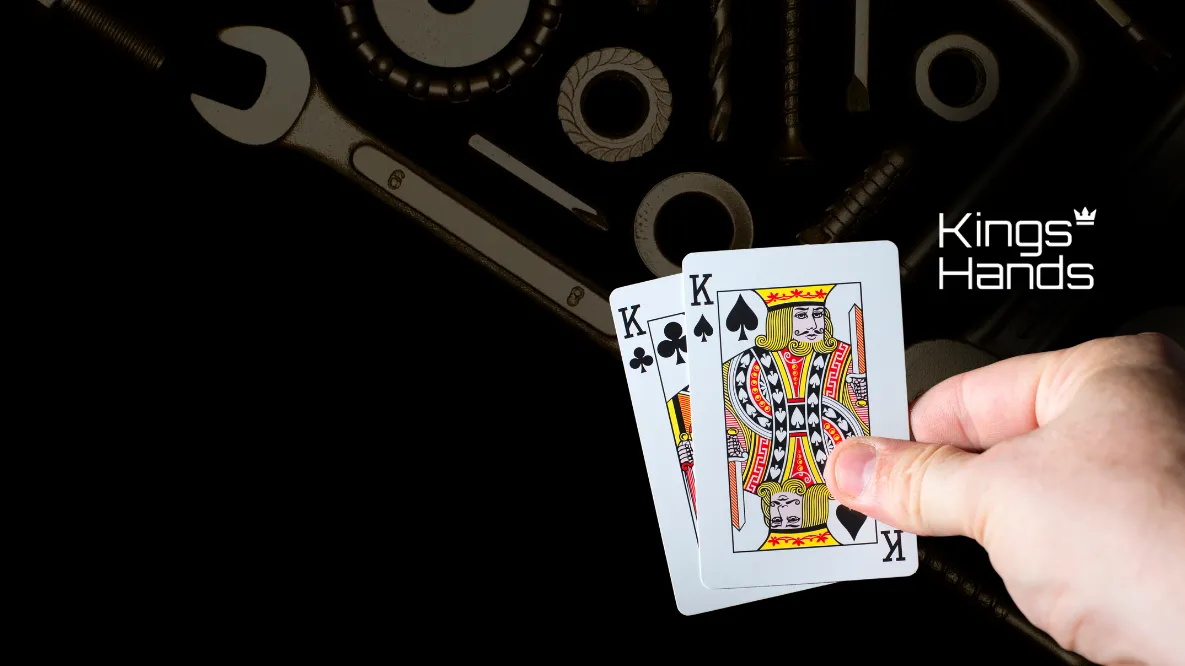We’ve come to the last position at the table where you can have an opening range – the Small Blind. While there’s only one player left to act after us, we can’t afford to open every hand in the hopes that they fold, as we still have to play postflop a good percentage of the time. Therefore we need to build an opening range that allows us to steal the blinds without being vulnerable postflop.
We’ll be taking a look at exactly how you do that, as we look into how to construct your Small Blind opening range and how you should be adjusting it based on how the big blind plays.
What is the Small Blind Position?
The Small Blind position is the position to the left of the Button position and to the right of the Big Blind position. At a nine-handed table, it is the eighth position to act preflop. It is referred to as the “Small Blind” position, as the players in this position must post a small amount of money before seeing their cards.

How Should You Play From the Small Blind?
The Small Blind is an interesting position and is often considered to be one of the hardest to play at the poker table. When action folds to you, you have one major advantage and one major disadvantage to deal with. The advantage is that there’s only one player left to act after you, which makes stealing the blinds much easier.
However, the disadvantage is that you’re guaranteed to be out of position postflop, making it harder to play if you get called. When playing from the Small Blind, you need to raise wide enough to steal the blinds frequently without having an unbalanced range that’s difficult to manage postflop.
The value of stealing the blinds is important when you’re in the Small Blind, as you’re starting the hand with a -0.5bb loss every time – if you’re able to get that back plus an extra big blind, that’s a huge win.
How Do We Construct a Small Blind Opening Range?
So, you want to raise a wide range of hands, without unbalancing your range – how do we go about doing that? Well, usually, we’d build on the range of the previous position, but as we’re not in as strong of a position, we’re actually going to be working backwards from our Button opening range.
Ideally, we want to play slightly tighter from the Small Blind than we do from the Button. This allows us to raise a wide range and frequently steal the blinds without being too unbalanced postflop. As we’re playing tighter from this position, we need to work out what hands we’re removing from our Button opening range.
The best way to do this is to start by removing the weakest hands in our range. While the term “weakest” may be subjective (after all, is 53s better or worse than K6o?), we’d recommend removing hands that are either low value, disconnected, or both. Hands like K6o are disconnected and aren’t particularly strong, 42s is too weak, and 54o is also too weak.
After removing a few of these hands, you approach what a standard Small Blind opening range should look like.
Small Blind Base Opening Range
At a nine-handed cash game table with 100bb, we recommend that your baseline Small Blind opening range should look something like this:
49.26% – 22+, A2s+, K2s+, Q4s+, J7s+, T8s+, 97s+, 86s+, 75s+, 64s+, 53s+, 43s, 32s, A2o+, K7o+, Q8o+, J8o+, T8o+, 97o+, 87o, 76o, 65o

This is the first time we’ve seen an opening range decrease in size during this series, which is due to the disadvantages faced by the player in the Small Blind compared to the Button. These disadvantages mean that we need to slightly tighten our range, but there are still enough advantages to allow us to open a pretty substantial range – nearly half the hands we’re dealt.
Some of the hands that have hit the cutting room floor include some of our weakest suited/offsuit broadway hands and our weakest suited/offsuit connectors. When playing in the Small Blind, you have to be mindful that you’re going to be out of position postflop. This makes playing a wide range extremely difficult to manage, and the only reason why we’re able to raise such a wide range from this position is due to the likelihood that we get to steal the blinds.
The frequency at which we win the blinds compensates for the fact that we are going to have a tough time realising our EV when we play postflop. While the big blind will be defending with a wide range, they have the benefit of position and are able to put pressure on us postflop.
By eliminating some of the worst hands from our Button opening range, we make our postflop range slightly more manageable, as we have fewer low-EV hands to deal with, while still stealing the blinds often enough.
Raising from the Small Blind is a delicate balancing act, and it takes a lot of practice to master playing this position.
Adjusting Your Range
With only one player left to act after you, you have the flexibility to make large adjustments based on how your opponent plays. No longer do you have to be worried about the really aggro guy amongst a table of nits; you can simply adjust to how the big blind is playing against you.
Let’s take a look at how you should adjust based on how the big blind is playing against your raises.
How You Should Adjust at a Tight Table?
If you’re playing against a big blind that plays too tight, the best way you can exploit them is by dramatically increasing your opening range. We’ve already discussed how important stealing the blinds is when you’re in the Small Blind, so you should take any extra opportunity that’s given to you.
However, to optimally exploit your opponent, you need to pay attention to how often they’re folding. This is easy to do in an online poker game where you can use a HUD, but if you’re playing live, you need to pay attention to the hands that they showdown. Are they playing extremely tight? Or are they just folding the bottom 10% of their hands?
Knowing this will allow you to better adjust your raising range to exploit your opponent. For example, if they’re only folding the bottom 5-10% of hands they should be playing, then you can make a small adjustment to your opening range that exploits that. However, if they’re dramatically overfolding, you can start raising every hand, knowing that you’re going to automatically profit in the long run.
How You Should Adjust at a Loose Table?
When playing against a big blind that’s playing too loose, we need to make the opposite adjustment. We’re no longer as concerned about stealing the blinds, as our loose opponent won’t let that happen; instead, we’re more concerned about playing a range that will dominate our opponent postflop.
If the player in the big blind is a loose-passive player who predominantly calls your preflop open, you should tighten your range and remove the bottom 5-10% of hands. We want to play hands that are going to dominate our opponent, so hands like K7o, Q4s, etc. aren’t going to cut it. By eliminating the worst hands from our range, we don’t steal the blinds as often, but we perform much better postflop against our opponent’s calling range.
If you’re playing against an aggressive opponent who often 3bets against your range, we should also look to tighten our opening range – but for a different reason. When an opponent is aggressive preflop, they deny us the chance to realise our equity, which means that the value of our weakest hands decreases to the point that they no longer become profitable. We’d still recommend removing hands like K7o and Q4s over hands like 53s, as 53s performs much better against a 3bet than weak broadway hands.
Summary
The Small Blind is a tough position to play, as you’re constantly getting pulled between the advantage of only having one player left to act, and the disadvantage of being out of position postflop. While we need to raise a wide range to steal the blinds, we can’t raise too wide of a range and leave ourselves vulnerable postflop.
That’s why we raise a range that’s slightly tighter than the Button opening range – wide enough to steal the blinds at a frequent rate while being slightly easier to manage postflop. After reading this article, you should now be armed with the knowledge to raise the Small Blind with confidence, knowing how you should adjust if your opponent in the Big Blind is playing too loose or too tight.
Stay tuned for our final article on preflop opening ranges, where we’ll be recapping everything we’ve covered, by following us on Facebook and Instagram.





















